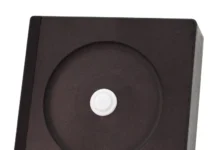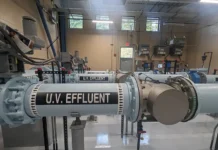Jennifer Osgood, PE, PMP, BCEE
associate, CDM Smith
While UV reactor lamp breakage occurrence is uncommon, if lamp breakage does occur, utilities need to have a plan in place and understand the consequences. Conducting a mercury release analysis provides insight into the measurable public health risk associated with lamp breakage. Observations and insight associated with UV reactor lamp breakage are covered within this article.
Lamp breakage may occur outside a UV reactor. Typically, this type of incident is associated with replacing lamps. Mercury is in a liquid phase. The primary risk posed is to workers that may come in contact with the spilled mercury. Mercury vacuums are available for clean-up. However, proper procedures and training are necessary to safely contain the mercury.
Lamp breakage also may occur while the UV reactor is online. Typically, this type of incident occurs while water is flowing through the reactor. Online lamp breakages occur due to any one of the following reasons: Incorrectly manufactured sleeves or faulty design, wiper mechanism issues, software error leading to an overheating, power surge, debris, burst main downstream of the plant that resulted in a significant increase in flow rate through the system, control logic fault caused the flow control valve to open unexpectedly quickly, or excessive rate of flow increase resulted in an exceedance of the maximum flow rating through a single UV reactor. When the reactor is online, mercury is in a vapor state due to the high temperatures. Mercury maximum contaminant limits (MCL) are currently set at a concentration of 2 µg/L in the US and 1 µg/L in Canada.
Mercury release calculations determine the magnitude of mercury plume concentration in finished water for different lamp breakage scenarios. These calculations should be based on mercury mass in the vapor phase. Mercury mass in liquid and vapor phase in operating UV lamps depends on lamp type and operating pressure and temperature. Mercury mass in the vapor phase may be treated as proprietary information by the UV reactor manufacturer. If so, one may need to rely on ideal gas law values based on pressure and temperature to calculate.
Lamp breakage scenarios associated with mercury release calculations should consider the appropriate post UV configuration, such as a pipeline release scenario: UV systems discharge directly into the distribution system, i.e., no finished water storage buffer between the UV system and first customer; or a clearwell release scenario: UV systems followed by a finished water clearwell or storage reservoir prior to first customer. There also are several lamp breakage scenarios: one lamp, one reactor; all lamps, one reactor; and all lamps, all in-service reactors.
The UV knowledge base (2010) outlines a step-by-step response plan for online lamp breakage. Bold font indicates medium-pressure (MP) activities only. Non-bold font indicates MP and low-pressure, high-output (LPHO) activities
- Close valve sufficiently downstream of reactor to contain initial mercury release (LPHO-containment of the initial releases likely not needed because mercury concentrations are orders of magnitude below the MCL).
- Close upstream and downstream reactor isolation valves.
- Divert water contained in the conduit to waste, MERSORB® (or equal mercury absorbent) treatment or storage.
- Sample conduit water before and after treatment as needed.
- Flush conduit and bring back online.
- Pump contaminated water in reactor to a MERSORB® column for treatment.
- Sample reactor water before and after treatment.
- Clean up reactor. Remove quartz shards, liquid mercury and lamp parts.
- Inspect other sleeves. Replace broken and damaged sleeves and lamps.
- Flush reactor with dilute acid solution HCl followed by water
- Verify mercury concentrations in standing water are acceptable.
- Bring reactor back online.
A site-specific UV lamp breakage response plan should describe operating procedures, sample locations, frequency of sampling, if any treatment and disposal is needed, and proper clean-up and disposal of the mercury, based on industry best practices. Sampling locations downstream of the reactor should be selected based on the concentration profiles predicted using a model.
Due to the larger mercury concentration in vapor phase, MP UV reactor lamp breakage poses higher risk when compared to LPHO reactor lamp breakage. For a pipeline mercury release scenario, flow appears to have minimal impact on mercury dilution concentrations and plume displacement increases at lower flows (i.e., longer detention time).
For a clearwell mercury release scenario, the peak mercury concentrations are typically similar in baffled and unbaffled clearwells; however, the plume displacement profile is extended in unbaffled clearwells. Clearwell volume dilution calculations, adjusted by baffle factor, may underestimate the peak mercury concentrations and length of the plume displacement. Computational fluid dynamic model or tracer test results provide a more accurate prediction of downstream mercury dilution impacts.
Operators Corner focuses on the practical aspects and lessons learned by the owners, operators and providers of UV technology. Authors for these articles are solicited from individuals operating full-scale UV facilities around the globe. Those interested in submitting an applied article please contact [email protected].
Contact: [email protected]




